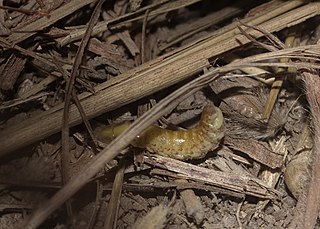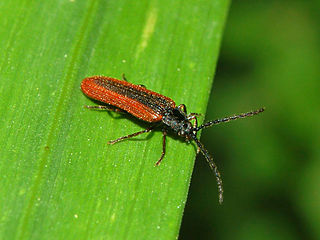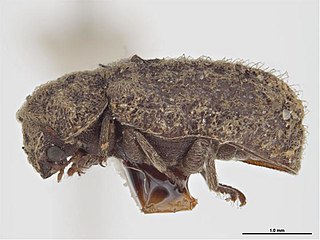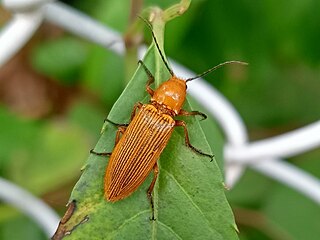
The soldier beetles (Cantharidae) are relatively soft-bodied, straight-sided beetles. They are cosmopolitan in distribution. One of the first described species has a color pattern reminiscent of the red coats of early British soldiers, hence the common name. They are also known commonly as leatherwings because of their soft elytra.
Glowworm or glow-worm is the common name for various groups of insect larvae and adult larviform females that glow through bioluminescence. They include the European common glow-worm and other members of the Lampyridae, but bioluminescence also occurs in the families Elateridae, Phengodidae and Rhagophthalmidae among beetles; as well as members of the genera Arachnocampa, Keroplatus and Orfelia among keroplatid fungus gnats.

Elateriformia is an infraorder of polyphagan beetles. The two largest families in this group are buprestids, of which there are around 15,000 described species, and click beetles, of which there are around 10,000 described species.

The Elateroidea are a large superfamily of beetles. It contains the familiar click beetles, fireflies, and soldier beetles and their relatives. It consists of about 25,000 species.

Cleroidea is a small superfamily of beetles containing over 10,000 species. Most of the members of the group are somewhat slender, often with fairly soft, flexible elytra, and typically hairy or scaly.

Byrrhoidea is a superfamily of beetles belonging to Elateriformia that includes several families which are either aquatic or associated with a semi-aquatic habitat. Other than the superfamily Hydrophiloidea, most of the remaining Polyphagan beetles which are aquatic are in this superfamily.

The Rhagophthalmidae are a family of beetles within the superfamily Elateroidea. Members of this beetle family have bioluminescent organs on the larvae, and sometimes adults, and are closely related to the Phengodidae, though historically they have been often treated as a subfamily of Lampyridae, or as related to that family. Some recent evidence suggested that they were the sister group to the Phengodidae, and somewhat distantly related to Lampyridae, whose sister taxon was Cantharidae, but more reliable genome-based phylogenetics placed as the sister group to the Lampyridae.

Ptinidae is a family of beetles in the superfamily Bostrichoidea. There are at least 220 genera and 2,200 described species in Ptinidae worldwide. The family includes spider beetles and deathwatch beetle, as well as the cigarette, drugstore and furniture beetles.

Laemophloeidae, lined flat bark beetles, is a beetle family in the superfamily Cucujoidea characterized by predominantly dorso-ventrally compressed bodies, head and pronotal discs bordered by ridges or grooves, and inverted male genitalia. Size range of adults is 1–5 mm (0.04–0.2 in) in length. Currently, it contains 40 genera and about 450 species, and is represented on all continents except Antarctica; species richness is greatest in the tropics.

The Omalisinae are a small subfamily of morphologically derived elaterid beetles. The Omalisinae were long considered an independent family in the deprecated family Cantharoidea, and later a family in the Elateroidea, but molecular phylogenies have demonstrated the morphological similarity of Omalisinae to other soft bodied beetles is a case of parallel evolution (homoplasy) of their soft bodies, rather than an apomorphy. Members of this beetle subfamily have been reported to have bioluminescent organs on the larvae, although no recent publications have confirmed this. Some recent evidence indicated they were the sister group to a clade comprising the families Rhagophthalmidae and Phengodidae, however a more comprehensive phylogenetic analysis based on genome sequences strongly supported the Omalisinae as being contained within the Elateridae.

Omethidae is a family of Elateroidea sometimes known as the false soldier beetles. They are native to South, Southeast and Eastern Asia and the Americas. Their biology is obscure and their larvae are unknown. They appear to inhabit vegetation in or surrounding forests, and are probably active during the day.

Silinae is a subfamily of soldier beetles in the family Cantharidae. There are about 6 genera and more than 180 described species in Silinae.

Omethes is a genus of false soldier beetles in the family Omethidae. There are at least two described species in Omethes.

Endecatomus is a genus of beetles, the sole member of the family Endecatomidae. There are at least four described species in Endecatomus. Endecatomidae was formerly treated as a subfamily of Ciidae or Bostrichidae. They are found in the Holarctic region. Adults and larvae feed on the fruiting bodies of bracket fungus, creating bored cavities as they do so.

Hemiopinae is a subfamily of click beetles in the family Elateridae. There are at least four genera in Hemiopinae.
Lissominae is a subfamily of click beetles in the family Elateridae. There are about 11 genera in Lissominae.
Physodactylinae is a subfamily of click beetles in the family Elateridae. There are at least two genera in Physodactylinae.
Pityobiinae is a subfamily of click beetles in the family Elateridae. There are at least two genera and two described species in Pityobiinae.

Telegeusinae is a small subfamily of beetles in the family Omethidae recognizable by enlarged palpi found in males. Though relatively rare, males are sometimes found in large numbers in black light traps. Females are not known in this group, but it is theorized that females are larviform as found in many closely related taxa.














